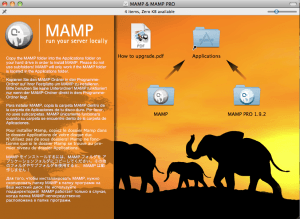

- #Mamp update multiple folders how to#
- #Mamp update multiple folders for mac os x#
- #Mamp update multiple folders install#
- #Mamp update multiple folders code#
And add the below configurations to the file LoadModule php7_module /Applications/MAMP/bin/php/php7.3.9/modules/libphp7.so Create a file called nf in the in the extra folder as we declared in the previous file.Add this to the bottom of the nf file Include /Applications/MAMP/conf/apache/extra/nf At the bottom of the nf file, you’ll see where additional configurations are loaded from the extra folder.It could be LoadModule php5_module, depending on your version. Search for and comment the followiing line – LoadModule php7_module. Open this file in your favourite text editor /Applications/MAMP/conf/apache/nf.
#Mamp update multiple folders how to#
But the MAMP version in your system comes with pre-installed version of PHP, and you want to go with it.īut this tutorial is explaining how to change php version in MAMP.
#Mamp update multiple folders install#
So this is fixed by changing the following lines in the ' core/Common.php' file.It’s very often that you want to change the PHP version in order to install different softwares in your development environment. NOTE CodeIgniter 2.2.0 issue: One thing I noticed when testing some CodeIgniter apps was an error messages started appearing which was caused by the php version 5.6.0. Now when you start the browser and input for example it should work fine without any issues, plus based on the same procedures as above you can add other subdomains for testing. Now you can restart both ' Apache Server' and ' MySQL Server' by pressing the ' Stop Servers' and then ' Start Servers' button in MAMP but I prefer to reboot my computer to be safe. You will need to enter your username and password to do this. Then place it back in the original folder replacing the older file.
#Mamp update multiple folders code#
So for my example I added the following line of code at the end of the file. private/etc/hosts/įrom the resulting window you will need to edit the file named ' hosts', but due to file permissions it's easier to copy it to your desktop and edit it from there via any text editor. Goto the finder menu again and choose the dropdown Go-> Go to Folder. Options Indexes FollowSymLinks MultiViews Listen 80ĭocumentRoot /Applications/MAMP/htdocs/yourwebsite So for this example I want the subdomain. Applications/MAMP/conf/apache/įrom the resulting window open the file named ' nf' and find where it says ' Listen 80' and add the following afterwards, remembering to change the folder and url to your own settings.

Goto the finder menu and choose the dropdown Go-> Go to Folder. To quickly test that its worked choose the ' Open WebStart page' and this should open up your browsers window with the new url starting with instead of Step 2: Edit the nf file It will now take you back to the MAMP apps landing screen and automatically reboot the MAMP Apache Server and MySQL Server - you maybe asked for your username and password. But this caused conflict on my machine so I simply renamed the Nginx Port back to 8888 as below. By default it should change the Apache Port to 80, Nginx Port to 80 and the MySQL Port to 3306. On the apps landing screen choose the ' Preferences.'.Ĭhoose the ' Ports' tab then click the ' Set Web & MySQL ports to 80 & 3306' button. Let's start by hiding the default url containing 8888 which is fairly straightforward by using the MAMP app. Step 1: Hide the :8888 from the localhost:8888 url

The following steps are based on you already having MAMP installed. It conflicts with Mac OS's Bonjur and causes a slow website. HINT: Try not to use the extension name of.
#Mamp update multiple folders for mac os x#
By default when installing MAMP for Mac OS X it will redirect you to the host url but what if you want to use a subdomain like for testing rather than Here is how I managed it using both Mac OS 10.10 (Yosemite) and MAMP version 3.0.7.


 0 kommentar(er)
0 kommentar(er)
